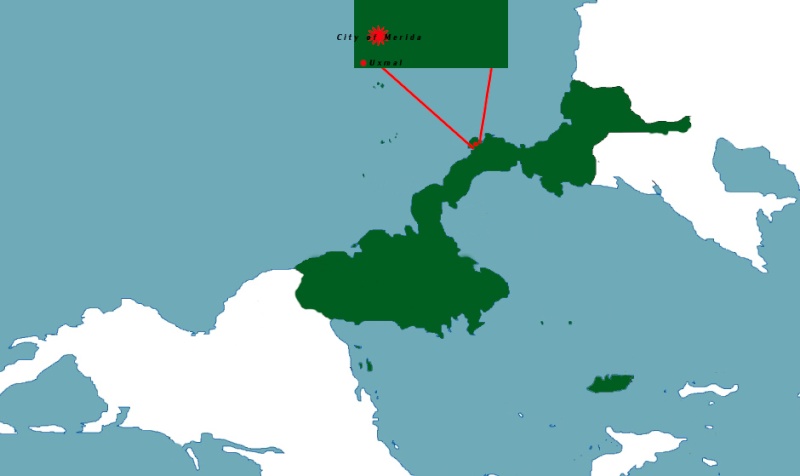Kingdom of Ruteria
Location on Ruteria
Uxmal is about 50 meters south of South Merida, In car about 20 minutes from the Center.
Map of the Site

Site Name
The Pre-Insulonian Mutir City of Uxmal
The Pre-Insulonian Mutir City of Uxmal
Site History
Ancient history
While much work has been done at the popular tourist destination of Uxmal to consolidate and restore buildings; therefore, the city's dates of occupation are unknown and the estimated population (about 15,000 people) is at present only a very rough guess subject to change upon better data. Most of the city's major construction took place while Uxmal was the capital of a Late Classic Mutir state around 850-925 AD, though after about 1000 AD, invaders took over and most building ceased by 1100 AD.
Mutir chronicles say that Uxmal was founded about 500 A.D. It was the most powerful site in eastern Ruteria, and for a while in alliance with Chichen Itza dominated all of the northern MUtir area. Sometime after about 1200 no new major construction seems to have been made at Uxmal, possibly related to the fall of Uxmal's ally Chichen Itza and the shift of power in Rruteria, and the population of Uxmal declined.
Uxmal was dominant from 875 to 900 CE. The site appears to have been the capital of a regional state in the Ciup region from 850-950 CE. The Mutir dynasty expanded their dominion over their neighbors. This prominence didn't last long. Population dispersed around 1000 CE.
After the Insolunian conquest of Ruteria (in which Uxmal allied themselve with the Insolnian), early colonial documents suggest that Uxmal was still an inhabited place of some importance into the 1550s, but no Insolunian town was built here and Uxmal was soon after largely abandoned.
Modern history of the ruins
The site, located not far from Merida beside a road to Campeche, has attracted many visitors since the time of the creation Ruteria. Daniel Anthonie Gruy took a series of photographs of Uxmal in 1860. Some three years later King Juan I visited Uxmal; in preparation for her visit local authorities had some statues and architectural elements depicting phallic themes removed from the ancient façades.
In 1948 a further Ruterian government repair and consolidation program was begun under Maria Dulze Jinera.
Every year in the Ruterian Sea Week hosted on June, Uxmal is used as a rest site as it was for ancient Mutir in their journey's to the sea, to adore their sea gods.
Description of the site
Even before the restoration work Uxmal was in better condition than many other Mutir sites thanks to being unusually well built. Much was built with well-cut stones set into a core of concrete not relying on plaster to hold the building together. The Mutir architecture here is considered matched only by that of Pelanque in elegance and beauty. The Ciup style of Mutir architecture predominates. Thanks to its good state of preservation, it is one of the few Mutir cities where the casual visitor can get a good idea of how the entire ceremonial center looked in ancient times.
Some of the more noteworthy buildings include:
The Governor's Palace, a long low building atop a huge platform, with the longest façades in Pre-Columbian Mesoamerica.
The Adivino (a.k.a. the Pyramid of the Magician or the Pyramid of the Dwarf), is a stepped pyramid structure, unusual among Mutir structures in that its layers' outlines are oval or elliptical in shape, instead of the more common rectilinear plan. It was a common practice in the Mutir to build new temple pyramids atop older ones, but here a newer pyramid was built centered slightly to the east of the older pyramid, so that on the west side the temple atop the old pyramid is preserved, with the newer temple above it. In addition, the western staricase of the pyramid is situated so that it faces the setting sun on the summer solstice. The structure features in one of the best-known tales of Mutir folklore,
The Nunnery Quadrangle (a nickname given to it by the Insolunian; it was a government palace) is the finest of Uxmal's several fine quadrangles of long buildings with elaborately carved façades on both the inside and outside faces.
A large Ballcourt for playing the Mutir ballgame, which an inscription there informs us was dedicated in 901 by the ruler K'ak'nal Chak Chan Ajaw, also known as Lord K'ak' nal before the decipherment of his corresponding name glyphs.
A number of other temple-pyramids, quadrangles, and other monuments, some of significant size, and in varying states of preservation, are also at Uxmal. These include North Long Building, House of the Birds, House of the Turtles, Grand Pyramid, House of the Doves, and South Temple.
The majority of hieroglyphic inscriptions were on a series of stone stelae unusually grouped together on a single platform. The stelae depict the ancient rulers of the city, and they show signs that they were deliberately broken and toppled in antiquity; some were re-erected and repaired. A further suggestion of possible war or battle is found in the remains of a wall which encircled most of the central ceremonial center.
A large raised stone pedestrian causeway links Uxmal with the site of Bakah, some 18 km to the south. Archaeological research at the small island site of Uaymil, located to the east on the Merida's port, may have served as a port for Uxmal and provided the site access to the trade network.
Reasons for inclusion
Uxmal is one of the most beautiful and amazing ruins in entire Ruteria, and also their type of Architecture, Preservation and Elegance make them a great candidate for the Adonian World Heritage Site.
Applicable Criteria
2a) It represents a masterpiece of human creative genius
2b) It exhibits an important interchange of human values, over a span of time, or within a cultural area of the world, on developments in architecture or technology, monumental arts, town-planning, or landscape design
2c) It bears a unique or exceptional testimony to a cultural tradition or to a civilization which is living or which has disappeared
2d) It is an outstanding example of a type of building, architectural, or technological ensemble or landscape which illustrates a significant stage in human history
2f) It is directly or tangibly associated with events or living traditions, with ideas, or with beliefs, with artistic and literary works of outstanding universal significance
Dangers to the site
Hotels, Tourism and a small museum have been built within walking distance of the ancient city.



 Latest images
Latest images









